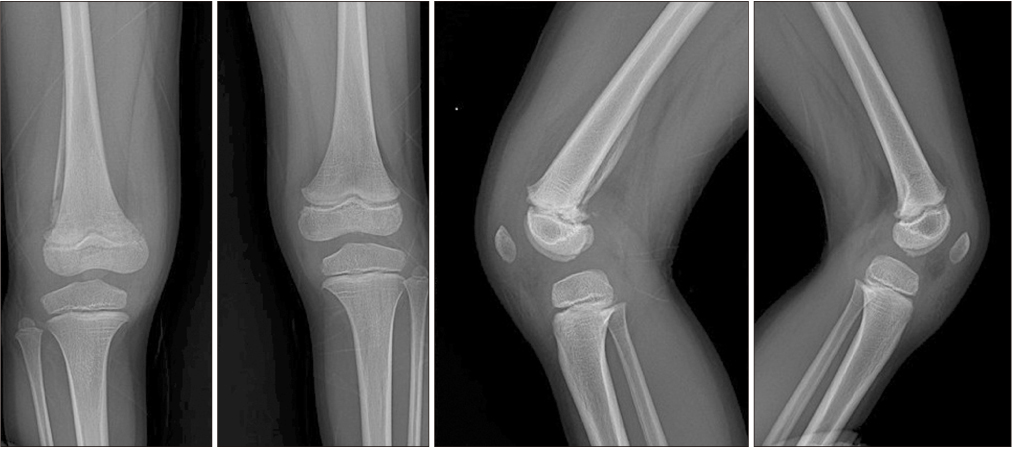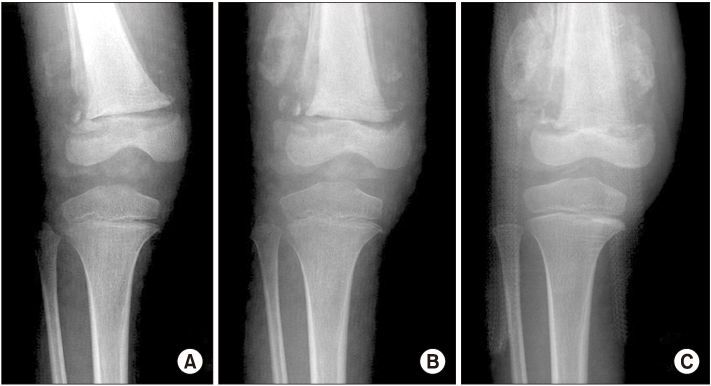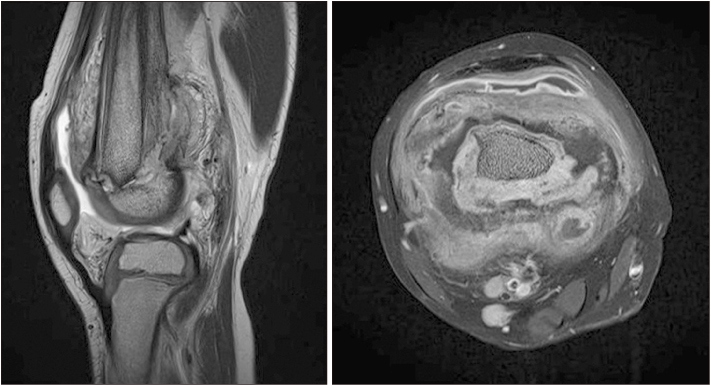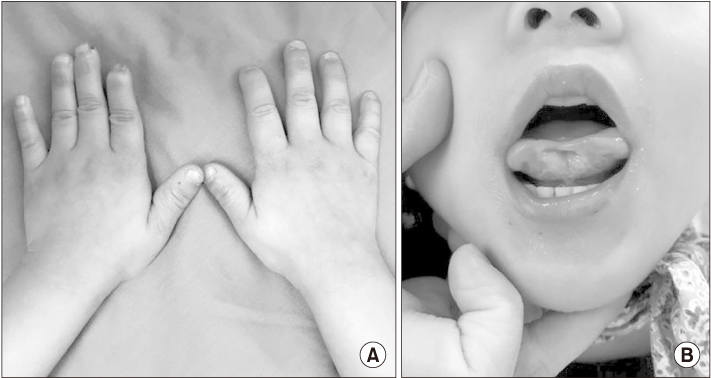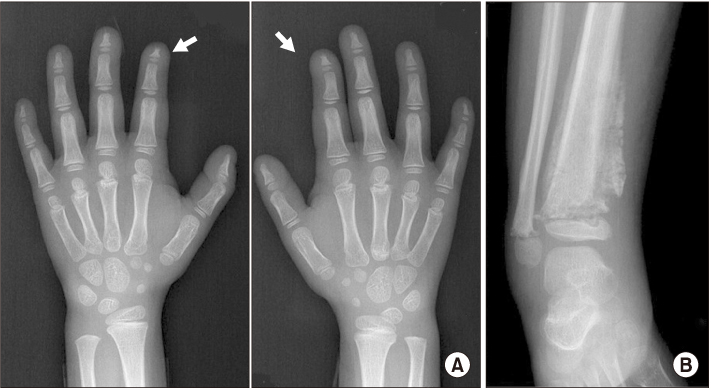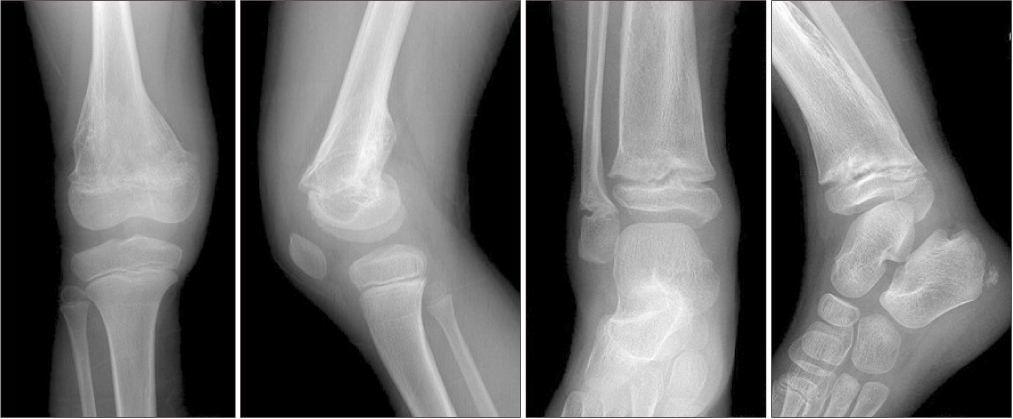J Korean Orthop Assoc.
2019 Oct;54(5):463-468. 10.4055/jkoa.2019.54.5.463.
Congenital Insensitivity to Pain with Anhidrosis: Five-Year-Old Girl with a Neglected Distal Femur Fracture
- Affiliations
-
- 1Department of Orthopedic Surgery, Pusan National University Yangsan Hospital, Pusan National University School of Medicine, Yangsan, Korea. nari1006@gmail.com
- KMID: 2461238
- DOI: http://doi.org/10.4055/jkoa.2019.54.5.463
Abstract
- Congenital insensitivity to pain with anhidrosis (CIPA) is a rare disease that affects the sensory and autonomic nervous system. The patients do not have the ability to sense different sensations, such as pain, which tends to lead to different injuries. In addition, the patients suffer from fluctuations in body temperature due to autonomic involvement. The present case was a five-year-old girl with a neglected distal femur fracture. X-rays taken during the follow-up showed marked callus formation and pseudarthrosis of the distal femur. She had biting injuries of the tongue, auto-amputation of the fingers, some developmental delay and a history of recurrent fever with an unknown origin. The electrodiagnostic study was normal. The quantitative sudomotor axon reflex test revealed markedly reduced postganglionic sudomotor axonal responses at all sites recorded on the left. She was diagnosed with CIPA. As the initial presentation of CIPA involves the musculoskeletal system, orthopedic surgeons should have a high index of suspicion.
Keyword
MeSH Terms
Figure
Reference
-
1. Freeman R. Autonomic peripheral neuropathy. Lancet. 2005; 365:1259–1270.2. Bar-On E, Weigl D, Parvari R, Katz K, Weitz R, Steinberg T. Congenital insensitivity to pain. Orthopaedic manifestations. J Bone Joint Surg Br. 2002; 84:252–257.3. Rotthier A, Baets J, De Vriendt E, et al. Genes for hereditary sensory and autonomic neuropathies: a genotype-phenotype correlation. Brain. 2009; 132:2699–2711.4. Edvardson S, Cinnamon Y, Jalas C, et al. Hereditary sensory autonomic neuropathy caused by a mutation in dystonin. Ann Neurol. 2012; 71:569–572.5. Leipold E, Liebmann L, Korenke GC, et al. A de novo gain-of-function mutation in SCN11A causes loss of pain perception. Nat Genet. 2013; 45:1399–1404.6. Chen YC, Auer-Grumbach M, Matsukawa S, et al. Transcriptional regulator PRDM12 is essential for human pain perception. Nat Genet. 2015; 47:803–808.7. Swanson AG. Congenital insensitivity to pain with anhydrosis. A unique syndrome in two male siblings. Arch Neurol. 1963; 8:299–306.8. Indo Y, Tsuruta M, Hayashida Y, et al. Mutations in the TRKA/NGF receptor gene in patients with congenital insensitivity to pain with anhidrosis. Nat Genet. 1996; 13:485–488.9. Indo Y. Genetics of congenital insensitivity to pain with anhidrosis (CIPA) or hereditary sensory and autonomic neuropathy type IV. Clinical, biological and molecular aspects of mutations in TRKA(NTRK1) gene encoding the receptor tyrosine kinase for nerve growth factor. Clin Auton Res. 2002; 12 Suppl 1:I20–I32.10. James WD, Berger TG, Elston DM. Andrews' diseases of the skin: clinical dermatology. Philadelphia: Saunders Elsevier;2006. p. 546.
- Full Text Links
- Actions
-
Cited
- CITED
-
- Close
- Share
- Similar articles
-
- Total Intravenous Anesthetic Management of a Child with Congenital Insensitivity to Pain with Anhidrosis : A case report
- Anesthetic Management in a Patient with Congenital Insensitivity to Pain with Anhidrosis: A case report
- Complication of Lateral Condyle Fracture of Humerus in a Patient with Hereditary Sensory Autonomic Neuropathy Type IV: A Case Report
- A Case of Congenital Insensitivity to Pain with Anhidrosis
- A Case of Generalized Xerotic Eczema in a Patient with Congenital Insensitivity to Pain with Anhidrosis

